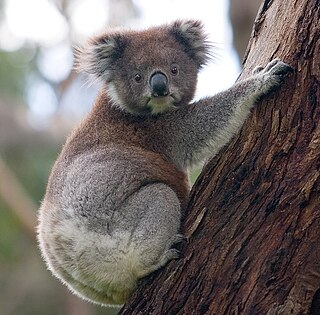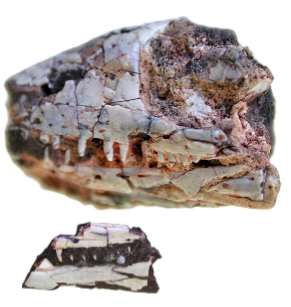
The Phascolarctidae is a family of marsupials of the order Diprotodontia, consisting of only one extant species, the koala, and six well-known fossil species, with another six less well known fossil species, and two fossil species of the genus Koobor, whose taxonomy is debatable but are placed in this group. The closest relatives of the Phascolarctidae are the wombats, which comprise the family Vombatidae.

The Vombatiformes are one of the three suborders of the large marsupial order Diprotodontia. Seven of the nine known families within this suborder are extinct; only the families Phascolarctidae, with the koala, and Vombatidae, with three extant species of wombat, survive.

Phascolarctos is a genus of marsupials with one extant species, the koala Phascolarctos cinereus, an iconic animal of Australia. Several extinct species of the genus are known from fossil material, these were also large tree dwellers that browsed on Eucalyptus leaves.

Thylacoleo is an extinct genus of carnivorous marsupials that lived in Australia from the late Pliocene to the Late Pleistocene, often known as marsupial lions. They were the largest and last members of the family Thylacoleonidae, occupying the position of apex predator within Australian ecosystems. The largest and last species, Thylacoleo carnifex approached the weight of a lioness. The estimated average weight for the species ranges from 101 to 130 kg.

Perameles is a genus of marsupials of the order Peramelemorphia. They are referred to as long-nosed bandicoots or barred bandicoots.

Thylacoleonidae is a family of extinct carnivorous diprotodontian marsupials from Australia, referred to as marsupial lions. The best known is Thylacoleo carnifex, also called the marsupial lion. The clade ranged from the Late Oligocene to the Late Pleistocene, with some species the size of a possum, while members of Thylacoleo reached sizes comparable to living big cats.

Phascolonus is an extinct genus of giant wombat known from the Pliocene and Pleistocene of Australia. There is only a single known species, Phascolonus gigas, the largest wombat ever known to have existed, estimated to weigh as much as 200 kg or 360 kg (790 lb). It was described by Richard Owen in 1859. Phascolomys magnus is a probable junior synonym. P. gigas is distinguished from other wombats by its strap-shaped upper incisors. The cranial roof is noticeably inwardly depressed. The species was abundant across Australia, with remains having been found in all states except Western Australia. It is suggested to have had a preference for arid and semi-arid inland habitats, with a diet consisting of a high amount of low quality vegetation. Though it likely had wide home-ranges, it probably did not stray far from fresh water sources. Abundant remains have been found in Pleistocene aged deposits from Lake Callabonna in South Australia. Unlike its living relatives, it is unlikely that Phascolonus engaged in burrowing. Phascolonus disappeared during the Late Pleistocene Quaternary extinction event around 50-40,000 years ago, together with many other large Australian animals, following the arrival of humans to the Australian continent. Phylogenetic analysis suggests that is closely related to the other giant wombat genera Ramsayia and Sedophascolomys.

Nototherium is an extinct genus of diprotodontid marsupial from Australia and New Guinea. This marsupial had hypsodont molars and weighed around 500 kg. It was a relative of the larger Diprotodon and a distant kin to modern wombats.

Diprotodontidae is an extinct family of large herbivorous marsupials, endemic to Australia and New Guinea during the Oligocene through Pleistocene periods from 28.4 million to 40,000 years ago.
Warendja is an extinct genus of wombat. It is known from two species, W. encorensis from the Late Miocene Riversleigh site in Queensland, and W. wakefieldi known from the Pleistocene of South Australia, New South Wales, and Victoria. The two species are primarily distinguished by features of their enamel. It became extinct as part of the Quaternary extinction event. Warendja wakefieldi is estimated to have weighed about 10 kg, considerably smaller than living wombats. Warendja thought to be relatively basal amongst wombats, being the most primitive member to possess hypselodont cheek teeth. The morphology of the humerus of W. wakefieldi suggests that it engaged in scratch-digging.
Ramsayia is an extinct genus of giant wombat, weighing around 100 kg. Ramsayia is known from two species, Ramsayia lemleyi from the Pliocene of Queensland, and Ramsayia magna from the Pliocene to Late Pleistocene of Queensland and New South Wales. The skull superficially resembles that of the giant beavers Castoroides and Trogontherium. The large premaxillary spine suggests it possessed a large fleshy nose. The shape of the skull of R. magna suggests that it did not engage in burrowing. Cladistic analysis suggests that it is closely related to the other giant wombat genera Phascolonus and Sedophascolomys. Like other giant wombats, its size is thought to have been adaption to feeding on large amounts of low quality vegetation. The only certain date of Ramsayia magna dates to the early Late Pleistocene, around 80,000 years ago, making the timing of its extinction uncertain.
Psilichthys is an extinct genus of prehistoric bony fish from Eumeralla Formation, the Lower Cretaceous epoch of what is now Victoria, Australia, known from single species P. selwyni. This is the first Mesozoic fossil vertebrate named from Victoria.

The Talbragar fossil site is a paleontological site of Late Jurassic (Tithonian) age in the central west of New South Wales, Australia. It lies about 30 kilometres (19 mi) north-east of the town of Gulgong, and 300 kilometres (190 mi) north-west of Sydney. The site has been known for over a century during which it has been extensively excavated to the point of near exhaustion. It is now registered as a Crown Land Reserve for the preservation of fossils; access is by permit, and the collection of rocks and fossil specimens is prohibited. The 4-hectare (9.9-acre) reserve is listed on the Register of the National Estate.

Osphranter is a genus of large marsupials in the family Macropodidae, commonly known as kangaroos and wallaroos. It contains the largest extant marsupial, the red kangaroo.
Cyclodendron was a genus of lycophytes dating from the Permian. Plants were vascularized with reproduction by spores.
Namilamadeta is an extinct genus of herbivorous marsupial from Australia that was around the size of a dog.

Bruce Norman Runnegar is an Australian-born paleontologist and professor at UCLA. His research centers on using the fossil record to determine how, where, and when life originated and evolved. He has published on a wide variety of topics, including the phylogeny of molluscs, Dickinsonia fossils and oxygen levels, and molecular clock techniques.

The Tupuangi Formation is a geological formation in New Zealand, only exposed on Pitt Island in the Chatham Islands. It is the oldest exposed sedimentary unit within the archipelago. It was deposited in terrestrial deltaic to paralic conditions during the Cenomanian to Turonian ages of the Late Cretaceous. During this time period the Chatham Islands were attached to Antarctica within the Antarctic Circle, at approximately 70° to 80° south.
Lasiorhinus angustidens was a species of wombat that lived during the late Pleistocene epoch to early Holocene years ago in eastern Australia. It is known from four isolated mandibles and teeth, all found in Darling Downs, Australia.

Kudnu is an extinct genus of neodiapsid reptile from the Early Triassic Arcadia Formation of Australia. The type species is K. mackinlayi.












